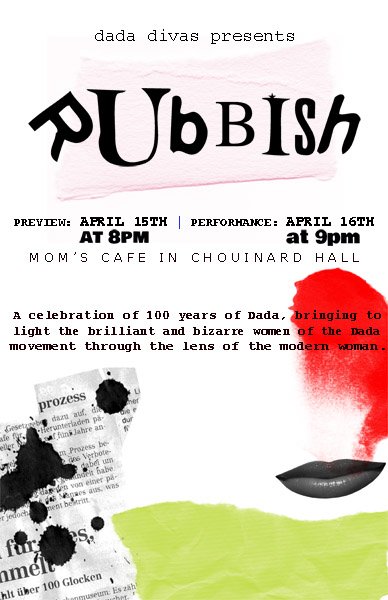Educational Resources and Spin-Offs
The Dada Divas team is deeply committed to arts education and offers educators a wide array of opportunities for integrating this project into classrooms and curricula across disciplines. Be it a college-level art history course or a middle school social studies class, Dada Divas provides rich points of entry for students of various ages and educational levels. Educator guides, project-based lesson plans, curricular tie-ins, supplemental reading suggestions, and even a full-semester syllabus are available upon request.
In addition, the Dada Divas team has developed a highly flexible workshop structure in which high school or college students build their own modular, non-linear musical/theatrical performance based on the work of female Dadaists. Guided by the artists of the Dada Divas team in collaboration with instructors from their own institution, students can research and devise their own tribute to the forgotten mamas of Dada.
For example, in 2015-16 and 2021-22 Jacqueline Bobak taught year-long courses at the California Institute of the Arts modeled on research and performance from Dada Divas. Students explored early 20th-century artistic movements, including Expressionism and Futurism as well as Dada, and studied the creative works and lives of female artists who were among the originators of the Dada movement. Each course culminated in student-generated performances—the first titled Rubbish, the second titled Dada Din-Din—that celebrated 100 years of Dada and illuminated the brilliant and bizarre women of Dada through a modern lens.
Dada Din-Din May 2022
Dada Din-Din, an opera generated by students at CalArts, was an immersive and interactive soirée with an open bar and intimate staging featuring original compositions, sonic collages, improvisations, and extended vocalizations. Collaboratively devised and performed by nearly two dozen students, Dada Din-Din consisted of selections from Jacqueline Bobak’s Dada Divas and original pieces by CalArts’ Opera-Theatre course, inspired by the works of women artists of the Dada movement: Emmy Hennings, Mina Loy, Baroness Elsa von Freytag-Loringhoven, Hannah Höch, Sophie Taeuber-Arp, Florine Stettheimer, Sayako Kishimoto, and others. Dada Din-Din featured such Dada performance practices and compositional techniques as juxtaposition, simultaneity, chance operations, satire, and fusion of high- and low-brow traditions. The opera’s pieces were an eclectic mix ranging from campy to grim, exploring womanhood, reproductive rights, sexual freedom, anti-capitalism, utopia, memory, war, and ritual.
Photos below by Angel Origgi
Rubbish April 2016
One of Dada’s major contributions to modern art, and a method utilized by the original Dada Divas, was the creation of art out of found objects or discards. Such “rubbish” was prevalent throughout this deliberately low-budget, do-it-yourself production, similar to what the artists at the Cabaret Voltaire in Zürich—the birthplace of Dada 100 years ago—created night after night. The venue at CalArts was a sort of "found" space, a well-worn lounge in a campus dorm. Costumes were assembled out of scraps from the college’s costume shop, items from thrift shops, “surprise bags” of left-overs and unsold merchandise at local craft stores, all put together with the liberal use of a glue gun and duct tape. The set is constructed primarily from garbage found in a municipal dump, assembled to create a living room. Costumes, make-up, music, and staging nod to the original historical era while adding a modern flair. Nearly all aspects of the production were designed and carried out by the students—from selecting texts to writing music, to staging, producing, making costumes, arranging publicity, and so forth.
Photos below by Anaïs

































